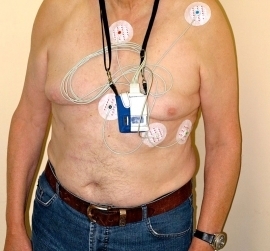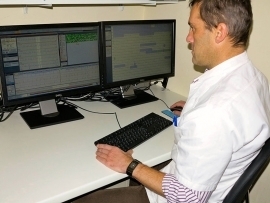Holter recorder
What is it?
What is it?A Holter recorder offers the opportunity to monitor your heart rhythm for 24 to 72 hours. It allows for the detection of heart rhythm disturbances that are not continuous and therefore may be missed in the brief period that an electrocardiogram is recorded.

What is the process?
What is the process?Preparation
Remove your upper clothing. The skin is degreased with ether and, if required, is shaved. Five adhesive electrodes, which are connected to a device that you will be wearing around your neck, are attached to your chest. This will take approximately ten minutes.
Procedure
You take the device home and carry out your daily activities as close to normal as possible. As the device is not waterproof, you may not shower or take baths. Playing sports is not advised because the electrodes may come loose due to sweating. You will be given a diary to note down your activities and symptoms. At the end of the examination (24 - 72 hours), you may disconnect the device yourself and return it to the secretariat. The test has no associated risks.
Aftercare
Skin irritation may occasionally occur where the electrodes were attached. If required, an anti-inflammatory ointment can alleviate the irritation.

Results
ResultsThe entire recording is analysed using a computer. Any flagged symptoms are studied carefully and potentially related to heart rhythm changes. Any daily variations and the heart rhythm disturbances are checked. The results will be communicated in writing to your GP.
Centres and specialist areas
Centres and specialist areas
Latest publication date: 16/05/2024
Supervising author: Dr Provenier Frank



